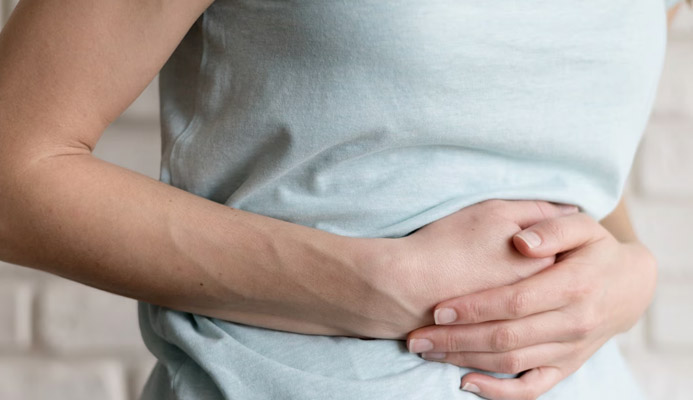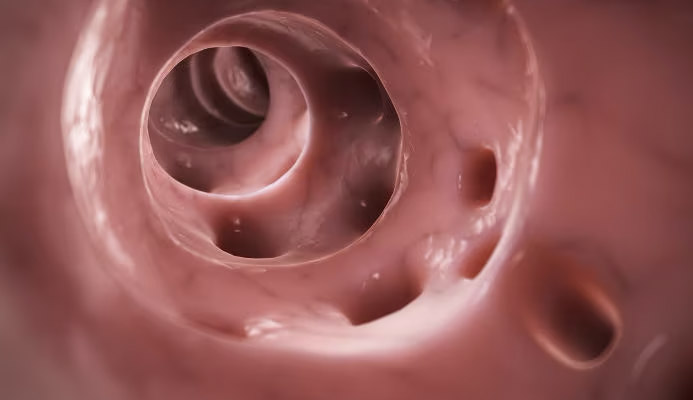
Do you practice anal sex often, even with casual partners?
Whether you are a man or a woman, anal sex is a potential source of infection for numerous STDs, which is why you should always be extra careful when practicing it.
Read this page, written by Dr. Luisella Troyer, to find out what major sexually transmitted diseases can be contracted through anal sex, and how to prevent them.
Anal candidiasis is caused by the uncontrolled proliferation of the Candida albicans fungus, normally present in our anal mucosa.
In normal siutations, this fungus is completely harmless, and indeed makes up the microbial flora of our ano-genital region, preventing other deleterious microorganisms from entering and doing harm.
Under conditions of immunodepression, however, the growth of the candida fungus may not be adequately kept in check by our immune system, thus giving rise to candidiasis.
Anal candidiasis is much more common in women than in men, and is a disease that is part of STDs (sexually transmitted diseases), as high fungal loads present in infected individuals can increase the level of proliferation of the partner who has had sexual intercourse (including anal), thus expanding the infection.
What are sexually transmitted diseases?

Sexually transmitted diseases (also abbreviated as STDs) are all those diseases, infectiously based, that can be transmitted, often preferentially, through sexual intercourse.
These are all diseases whose etiologic agent is a bacterium, virus, or parasite, which requires direct contact with the skin or mucous membrane to spread infection from host to host.
Since the dawn of human evolution, STDs have plagued the genus Homo, aided in part by the natural promiscuity of our species, common, moreover, to almost all other mammals.
It should be noted, for good scientific information, that STDs also or predominantly use sexual activity as their main mode of spread, but almost all of them, being direct-contact diseases, can still infect even not necessarily through the sexual act.
Since anal sex is part of the sexual act (heterosexual or otherwise), it too involves the necessary contact of the anus with genital organs or sex boys who, although less infectious, still can propagate microbial loads during intercourse.
What are the microorganisms responsible for sexually transmitted diseases?

STD infections are caused by microbes (i.e., tiny organisms, too small to be seen by our ocular focus), which in turn can belong to a variety of life forms:
- Bacteria, i.e., single-celled beings of the vast domain of prokaryotes, formed by a membrane, strands of DNA without a nucleus, and a variety of other organelles, all floating in the cytoplasm.
They are true organisms: they reproduce by cell duplication, feed and produce waste (that is, they have full metabolism) and die.
There are an endless number of types and families of them and, historically, along with viruses they are the main culprits of the most tremendous pandemics and epidemics in history;
- Protozoan parasites, i.e., tiny multicellular organisms also so small as to be invisible to our eyes that, like bacteria, have an autonomous metabolism.
They are called 'parasites' because their life cycle is always beneficial to the detriment of the host they attack, from which they steal energy resources and nourishment.
For example, the famous malaria, which has plagued human beings for millennia, is caused precisely by a parasitic protozoan;
- Mycetes, that is, widespread biological genus of organisms both macro (e.g., the edible mushrooms we eat) and from much smaller, invisible organisms, such as the famous Candida Albicans.
All fungi are parasites, as they prey on the host's energy resources, thus fueling their subsistence and reproduction;
- Viruses, that is, biological molecules that, unlike bacteria, protozoa and fungi, do not have all the structures to complete their life cycle, and therefore must exploit those of the host.
This is an extreme form of parasitism, and all viruses are basically little more than DNA coated in a protein capsule that, having penetrated the host's body, attacks the cells and forces them to produce, using energy and resources from the same cell, other viral specimens.
They are the smallest microorganisms responsible for an enormous number of infectious diseases, some relatively new (such as HIV), others known to human beings for millennia (such as herpes or influenza).
All of these microorganisms, which are present in so many families and types, have among the most diverse modes of infection: some are spread by air, that is, through the micro-droplets of saliva that, of course, we all produce while talking; others by the oro-fecal route, that is, also through unintentional contact or ingestion of feces; and still others require direct skin-to-skin or skin-to-mucosal contact.
Since the sexual act is a necessarily direct contact between two or more people, some of these microbes have developed a predilection for propagating themselves precisely through this practice, which is innate and inescapable in mammals.
What are the sexually transmitted diseases with anal sex?

The anal mucosa is unfortunately a prime gateway for micro-organisms that are the origin of sexually transmitted diseases.
This is because the anorectal canal, being formed precisely by mucosa, does not have the natural protection of skin, sending totally of epithelium.
And there is another problem: by its very nature, the mucosa of the intestine is hyper-absorptive, due to the very high presence lymphatic vessels that, normally, absorb chyle fluids (food waste before it becomes feces).
This pronounced propensity to be somewhat like a 'sponge', as well as the lack of protection due to the absence of the stratum corneum, make the anorectal canal particularly vulnerable to infection by microbes.
Again, normal vaginal fluids and the weakly acidic environment of the vagina are not present in the anus, which is usually sufficient to kill many pathogenic microorganisms, thus acting as a natural protective barrier during intercourse.
For these reasons, Medicine has long established that anal sex is definitely the riskiest form, speaking of microbial infections, of all sexual activities.
Currently, the World Health Organization has identified more than 30 established pathogens for sexually transmitted diseases.
Many of them are viruses, many more bacteria, while others are protozoa, molds or microscopic parasites.
All of them are spread and passed from host to host by direct contact during the anal sex act, mainly by penetration of the penis into the anus but, in some cases, also by oral sex.
Specifically, the main diseases transmissible by anal sex are:
- Gonorrhea, caused by the bacterium Neisseria gonorrhoeae;
- AIDS, caused by the HIV virus;
- Syphilis, caused by the bacterium Treponema pallidum;
- Ano-genital warts and (albeit in rare cases) anal cancer, caused by the HPV virus;
- Viral hepatitis B and C, caused by HBV and HCV viruses;
- Anal warts, caused by the fungus Candida Albicans;
- Scabies, caused by the mite Sarcoptes scabiei;
- Pubic pediculosis, caused by the infestation of Pthirus pubis pubis lice known as crabs
It is always worth remembering that many of these diseases, all of which are grossly highly infectious, can also be asymptomatic, especially in their early stages.
Therefore, the belief that a subject who is apparently 'healthy', with no visible lesions in the anus or genitals, is a subject who is actually free of infection is totally erroneous.
That is why any anal sex with casual partners should always be performed as safely as possible.
The term 'venereal disease,' the equivalent of sexually transmitted disease, is borrowed from the name Venus, that is, the Roman counterpart of the goddess Aphrodite.
In Greek mythology, the gods were not to be imagined as single, immutable deities, but rather as forces, acting on a specific sector of life or we might say, in the scientific hindsight of now, of reality.
Aphrodite was thus that deity who governed the forces of love, beauty, even the generation of life.
She had power over the whole sexual side of love, not only from the sentimental point of view, and therefore sexual relations, after the Roman conquest of Greece, were also gradually called venereal relations.
Mucosal tears during anal intercourse: the preferred entry route for viruses and bacteria

Of all sexual activities, anal sex is definitely the most risky activity with regard to STDs.
To the aforementioned absorptive property of the mucosa and lack of epithelium, the additional risk factor that makes anal sex so inherently unsafe is the high probability of micro-lacerations of the anal canal during intercourse.
In fact, every episode of anal sex involves inevitable micro-lacerations of the mucosa, which in turn are caused by penetrative activity.
Sometimes, these micro-lacerations are not so 'micro', and cases of patients coming to urgent care for genuine surgically relevant injuries are not uncommon.
Any laceration to the delicate anorectal mucosa is an invitation for viruses and bacteria, which are even easier to penetrate the already weak defenses of the anal area.
Statistically, for example, the risk of HIV infection is much greater during anal intercourse, which is why those most susceptible for this type of disease are homosexuals.
HIV is the pathogen that leads, without proper antiviral treatment, to the manifestation of AIDS, i.e., the famous (and dreaded) acquired immunodeficiency syndrome.
It is a virus belonging to the retroviruses, of rather recent mutation in human history, presumably originating from a zoonosis contracted by some African monkeys.
Its mode of transmission is mainly by sexual route, through contact with semen, vaginal fluid, pre-copulatory liquid.
Its transmission can also occur by blood, as the virus is also present in very high concentrations in the blood of the infected patient.
The virus rages against lymphocyte cells with CD4 protein, which are its natural host, replicating uncontrollably and then causing lysis (rupture) of the cell.
This, in the long run, leads to a slow but steady lowering of the patient's immune defenses, who gradually becomes permanently immune-compromised.
AIDS is the symptomatic manifestation of HIV infection, and is also its final form.
Although there is still no vaccine or defnitive cure for HIV infection, modern antiviral treatments are fortunately advanced enough to reduce the viral load in the blood and body fluids to a minimum, greatly prolonging the patient's life expectancy and making it roughly comparable to that of an uninfected person.
How can STDs be prevented during anal intercourse?

Unfortunately, as reiterated several times in this health article, anal sex always has inherent risks of infection, even using all possible precautions.
In the current state of Medicine, there is no preventive treatment that reduces the risk of infection during anal intercourse to zero, only good precautions that can lower the chances of infection.
Such good practices are:
- Abstention from all anal sexual practice;
- Avoid or moderate sexual promiscuity, preferring stable partners who, in turn, avoid promiscuity;
- Talk openly to your partner about past sexual experiences, including updating him or her on any examinations that have taken place;
- Protect penetration (both the active and passive parts) with a condom, using a strong, well-lubricated model;
- Always use copious amounts of water-based lubricant to minimize the chances of chafing and irritation of the anorectal canal;
- Stop the sexual act immediately if there is presence of pain or bleeding;
- Avoid mucosal wall contact with sperm fluid (potentially high viral load) as much as possible;
- Avoid penetrating the anus after you have penetrated the vagina, and vice versa;
- Avoid fellatio (oral sex) to the penis after anal sex act;
- Cleanse the anus well after each intercourse with gentle emollient cleanser;
- Perform periodic follow-up examinations, with related proctological examinations
All these good practices, it should be repeated, reduce the risks of STD infection, but they never eliminate them entirely.
What to do if you experience itching, burning or discomfort in the anus after anal sex?

Experiencing burning and discomfort in the anus after an anal penetrative sex act is quite normal.
Even if the anorectal canal is well lubricated, it is in fact highly likely that micro-injuries will be created during intercourse that will damage and inflame the mucosa.
It is precisely from those lesions that bacteria and viruses can enter the body, which can then initiate venereal disease.
In any case, even in the absence of infection, the anorectal mucosa after any intercourse may become inflamed and painful.
Along with pain, it is possible to develop an itching and burning sensation, a symptom of an onset of proctitis (an inflammation of the anorectal canal).
Usually, for non-serious conditions, these symptoms spontaneously regress in a few days, the time it takes for the mucosa to recover.
In these situations, of mild inflammation, it is usually sufficient to let the mucosa rest by avoiding other intercourse, keep the stool soft (by providing proper hydration and fiber intake) and, no less important, cleanse the anal orifice with gentle, nonaggressive cleansers, including the ever-useful rice starch.
The use of soothing creams, such as excellent ones with calendula and hyaluronic acid, can also provide relief from itching and burning.
If the symptoms do not spontaneously regress after a few days, if the pain or burning becomes unbearable, or if you experience bleeding from the anus (even light bleeding), it is imperative that you contact a Proctology Physician, for the mandatory proctological examination.
The anorectal mucosa is very rich, as is the entire colon, in lymph vessels.
In the small intestine, the lymphatic vessels are called chyliferous vessels because they convert the chyme of nutrition into chyle, essentially absorbing the fat.
Chyliferous vessels were first discovered by Gaspare Aselli over four hundred years ago, and with them the human lymphatic system was also discovered.
There are a very large number of lymph vessels scattered throughout the colon, and their task is the collection of fluids but also residual fat from the chyle, that is, the food now deprived of its nourishment by the villi of the small intestine.
This inherent characteristic of the anorectal mucosa is a problem with regard to hypothetical bacterial and viral infections: the mucosa tends to absorb everything, thus including microorganisms, and the lack of the stratum corneum makes the penetration of microbes much easier and faster than the outer skin.
This is why some STDs such as syphilis, HPV or HIV are much more easily transmitted through anal intercourse.
Do you think you have contracted an STD through anal intercourse? Dr. Troyer can help you

Dr. Luisella Troyer is a Proctologist Surgeon with over 30 years of experience in Proctology, prevention and treatment of venereal diseases transmitted through anal sex.
In her Dubai clinic, Dr. Troyer performs her proctological examinations with the help of an advanced electronic videoproctoscope, which can perfectly scan the entire anorectal canal, looking for even millimeter-sized lesions.
Thanks to the advanced technology of Electronic Endoscopic Videoproctoscopy and Dr. Troyer's experience, you can get more clarity on your medical condition, possibly starting the right treatment for your infection contracted during anal intercourse.
your proctologist surgeon of excellence in Dubai

Dr. Luisella Troyer is an italian Vascular Surgeon, specialised in Proctology and Colonproctology, operating in Dubai.
In the modern, well-equipped clinic in Dubai, Dr. Troyer provides specialist medical examinations in Vascular Surgery and Colonproctology, to diagnose and solve proctological problems such as:
- Pathological haemorrhoids;
- Haemorrhoidal thrombus;
- Anal fissures;
- Anal warts;
- Peri-anal abscesses and anal fistulas;
- Chronic constipation;
- Irritable Bowel Syndrome;
- Faecal incontinence;
- Rectocele;
- Descending perineum syndrome
In the clinic in Dubai, Dr. Troyer also performs minimally invasive treatments, such as the treatment of prolapsed haemorrhoids with the innovative sterilised air-stabilised scleromousse.
For her proctological diagnoses and examinations, Dr. Troyer uses the excellence of diagnostic technology, such as the modern high-definition videoproctoscope for Electronic Endoscopic Videoproctoscopy.
All operators and assistants of Dr. Troyer speak English, Arabic and Italian.
So remember...
- VENEREAL DISEASES OR SEXUALLY TRANSMITTED DISEASES ARE CALLED ALL THOSE INFECTIONS, CAUSED BY BACTERIA, VIRUSES, OR PARASITIC DISEASES ARE TRANSMITTED EXCLUSIVELY OR PREDOMINANTLY BY THE SEXUAL ROUTE;
- VENEREAL DISEASES HAVE BEEN PREVALENT IN THE SPECIES HOMO SAPIENS FOR MILLENNIA, DUE TO THE NATURAL POLYGAMOUS PROPENSITY OF OUR GENUS;
- ALL VENEREAL DISEASES REQUIRE DIRECT CONTACT TO SPREAD THE INFECTION;
- EXAMPLES OF VENEREAL DISEASES ARE ANAL CANDIDIASIS, GONORRHEA, SYPHILIS, HPV INFECTION (CONDYLOMATOSIS), HEPATITIS , AND HIV INFECTION;
- SEXUAL ACTIVITY USING THE ANUS AND ANORECTAL CANAL IS A PRIME SOURCE FOR THE SPREAD OF VENEREAL DISEASES;
- ANAL SEXUAL ACTIVITY IS INHERENTLY UNSAFE BECAUSE THE ANORECTAL MUCOSA IS DELICATE AND EASILY ATTACKED BY INFECTIOUS MICROORGANISMS;
- EVEN USING CONDOMS CORRECTLY, THERE IS ALWAYS A RISK OF CONTRACTION OF VENEREAL DISEASES;
- THE SMALL TEARS IN THE ANORECTAL MUCOSA THAT CAN OCCUR DURING PENETRATIVE INTERCOURSE ARE A PRIME GATEWAY FOR BACTERIA AND VIRUSES;
- SEXUAL PROMISCUITY WORSENS THE RISK OF CONTRACTING VENEREAL DISEASES;
- YOU SHOULDNEVER BE ASHAMED OF A POSSIBLE STD, BUT SHOULD ALWAYS SEEK HELP FROM A DOCTOR

This article was revised and updated by Dr. Luisella Troyer on:
Tuesday 4 February, 2025
Dr. Luisella Troyer is a Vascular Surgeon, specialising in Vascular Surgery and Proctology.
Since her training as a resident, Dr. Troyer has been interested in the study and treatment of proctological pathologies, especially haemorrhoids and haemorrhoid prolapses.
In the course of his practice as a Surgeon, he has accumulated about 5000 operating theatre hours as a first operator, of which about 120 were Milligan-Morgan haemorrhoidectomies.
He is one of the first Doctors to have studied and experimented with scleromousse therapy for pathological haemorrhoids, which he has judged to be the treatment of choice for the non-traumatic treatment of haemorrhoidal prolapses, with resolution statistics of over 95% and therefore often comparable with surgical access.

















